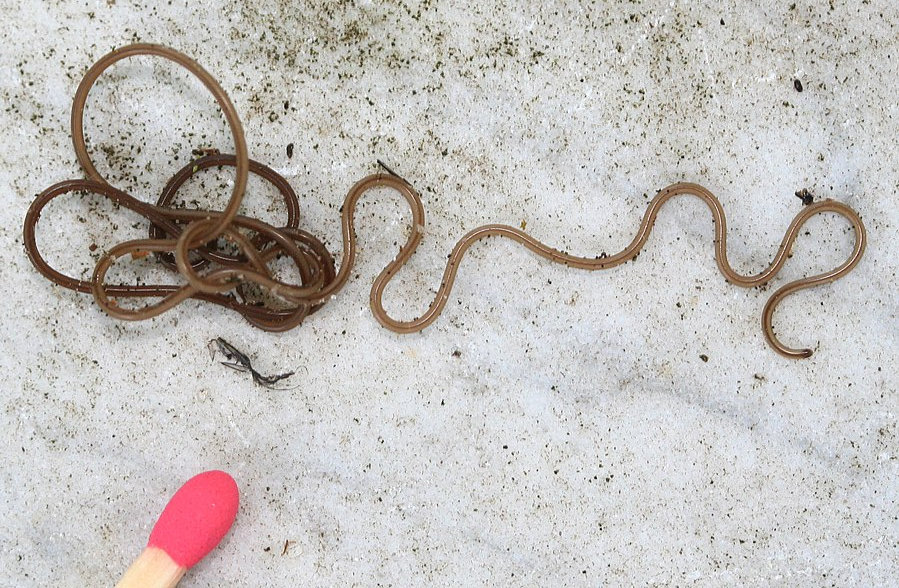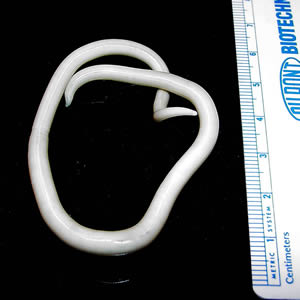- Home
- Garden Wildlife
- Roundworms
Roundworms
The roundworms belong to the two related phyla Nematoda and Nematomorpha. They are very distinctive creatures, sometimes linked as the clade Nematoida. Nematoids are distantly related to arthropods, not only sharing the growth by skin-shedding or ecdysis, but some biochemical characters as well.
They are all unsegmented elongate worms, round in section, and with very peculiar musculature, having only muscles running along the length of the body. Most worms have these longitudinal muscles, but have circular ones as well, running around the cross-section of the body. The two sets are complementary, making the worm shorter and fatter, or longer and thinner respectively. Nematoids manage with one set because they don't change their length materially, but actively flex their bodies from side to side in an eel-like movement1. To do this they need to maintain a high internal pressure, and therefore have to pump food in with a special muscular pharynx, and have special valves in their anus and reproductive openings.
The two roundworm phyla are very different in diversity and importance. The Nematomorpha, which we discuss in our page here, has only about 350 species recorded, but probably about 2,000 exist. They are relatively large, very elongate worms, and are all parasitic when immature and freshwater living as (non-feeding) adults.
Nematodes are a very different kettle of worms (?). It is very unclear how many species there are, with about 25,000 described so far, and a conservative estimate of 40,000 species globally. They live in all marine, freshwater and terrestrial habitats and under extreme conditions, and account for 80% of all the individual animals on the planet. A large proportion are parasites in vertebrates, including ourselves, while there are masses of free-living predatory and dead-matter recycling species and even more parasites of plants and other invertebrates.
The great nematode specialist Nathan Cobb (1859–1932) wrote:
"In short, if all the matter in the universe except the nematodes were swept away, our world would still be dimly recognizable, and if, as disembodied spirits, we could then investigate it, we should find its mountains, hills, vales, rivers, lakes, and oceans represented by a film of nematodes. The location of towns would be decipherable since, for every massing of human beings, there would be a corresponding massing of certain nematodes. Trees would still stand in ghostly rows representing our streets and highways. The location of the various plants and animals would still be decipherable, and, had we sufficient knowledge, in many cases even their species could be determined by an examination of their erstwhile nematode parasites." |
The final curiosity about the nematodes, is that no matter where they live, they look almost identical to each other, and are fiendishly difficult to tell apart except by size - but nearly all garden nematodes are microscopic. We cover the garden species as best we can here, but very little is known about their abundance, importance and ecology.

Typical adult nematomorph, very long and thin, but not tapering at the ends of the body
Reference
1. Jay Burr, A.H. and Forest Robinson, A. (2004) Locomotion Behaviour in Nematode Behaviour, Randy Gaugler and Anwar L. Bilgrami (eds). Cambridge, MA : CABI Publishing pp 25-62. Available here
Page drafted and compiled by Steve Head

The nematode Ascaris lumbricoides is the "large roundworm" found in people. Females are up to 49cm long, males are smaller, but both are vastly larger than most other nematodes. They live in our small intestine where they generally don't cause much problem unless present in large numbers when they can cause blockages.
Roundworms
The roundworms belong to the two related phyla Nematoda and Nematomorpha. They are very distinctive creatures, sometimes linked as the clade Nematoida. Nematoids are distantly related to arthropods, not only sharing the growth by skin-shedding or ecdysis, but some biochemical characters as well.
They are all unsegmented elongate worms, round in section, and with very peculiar musculature, having only muscles running along the length of the body. Most worms have these longitudinal muscles, but have circular ones as well, running around the cross-section of the body. The two sets are complementary, making the worm shorter and fatter, or longer and thinner respectively. Nematoids manage with one set because they don't change their length materially, but actively flex their bodies from side to side in an eel-like movement1. To do this they need to maintain a high internal pressure, and therefore have to pump food in with a special muscular pharynx, and have special valves in their anus and reproductive openings.
The two roundworm phyla are very different in diversity and importance. The Nematomorpha, which we discuss in our page here, has only about 350 species recorded, but probably about 2,000 exist. They are relatively large, very elongate worms, and are all parasitic when immature and freshwater living as (non-feeding) adults.

Typical adult nematomorph, very long and thin, but not tapering at the ends of the body
Nematodes are a very different kettle of worms (?). It is very unclear how many species there are, with about 25,000 described so far, and a conservative estimate of 40,000 species globally. They live in all marine, freshwater and terrestrial habitats and under extreme conditions, and account for 80% of all the individual animals on the planet. A large proportion are parasites in vertebrates, including ourselves, while there are masses of free-living predatory and dead-matter recycling species and even more parasites of plants and other invertebrates.
The great nematode specialist Nathan Cobb (1859–1932) wrote:
Reference
1. Jay Burr, A.H. and Forest Robinson, A. (2004) Locomotion Behaviour in Nematode Behaviour, Randy Gaugler and Anwar L. Bilgrami (eds). Cambridge, MA : CABI Publishing pp 25-62. Available here
Page drafted and compiled by Steve Head

The nematode Ascaris lumbricoides is the "large roundworm" found in people. Females are up to 49cm long; males are smaller, but both are vastly larger than most other nematodes. They live in our small intestine where they generally don't cause much problem unless present in large numbers when they can cause blockages.
"In short, if all the matter in the universe except the nematodes were swept away, our world would still be dimly recognizable, and if, as disembodied spirits, we could then investigate it, we should find its mountains, hills, vales, rivers, lakes, and oceans represented by a film of nematodes. The location of towns would be decipherable since, for every massing of human beings, there would be a corresponding massing of certain nematodes. Trees would still stand in ghostly rows representing our streets and highways. The location of the various plants and animals would still be decipherable, and, had we sufficient knowledge, in many cases even their species could be determined by an examination of their erstwhile nematode parasites."
The final curiosity about the nematodes, is that no matter where they live, they look almost identical to each other, and are fiendishly difficult to tell apart except by size - but nearly all garden nematodes are microscopic. We cover the garden species as best we can here, but very little is known about their abundance, importance and ecology.












